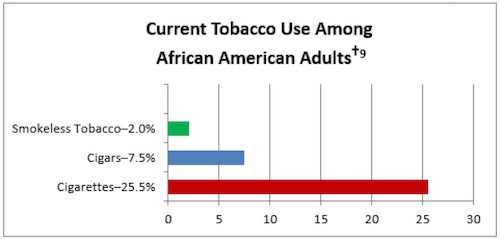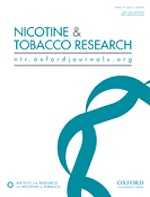African Americans and Tobacco Use
Black or African American is defined by the Office of Management and Budget as “a person having origins in any of the black racial groups of Africa.”1 There were over 42 million African Americans in the United States in 2014—approximately 13% of the U.S. population.2
Although African Americans usually smoke fewer cigarettes and start smoking cigarettes at an older age, they are more likely to die from smoking-related diseases than whites.3,4,5,6,7,8

Tobacco Use Prevalence
29.8% of African American adults reported current use* of tobacco in 2013.9
 * “Current Use” is defined as self-reported consumption of cigarettes, cigars, or smokeless tobacco in the past month.
* “Current Use” is defined as self-reported consumption of cigarettes, cigars, or smokeless tobacco in the past month.† Data taken from the National Survey on Drug Use and Health, 2013, and refer to African American adults aged 18 years and older.
Health Effects
Tobacco use is a major contributor to the three leading causes of death among African Americans—heart disease, cancer and stroke.3,4,5
- Diabetes is the fourth leading cause of death among African Americans.4 The risk of developing diabetes is 30–40% higher for cigarette smokers than nonsmokers.10
Patterns of Tobacco Use
- African American youth and young adults have significantly lower prevalence of cigarette smoking than Hispanics and whites.11
- Although the prevalence of cigarette smoking among African American and white adults is the same, African Americans smoke fewer cigarettes per day.3,6
- On average, African Americans initiate smoking at a later age compared to whites.3,6
Secondhand Smoke Exposure
African American children and adults are more likely to be exposed to secondhand smoke than any other racial or ethnic group.12
- During 2011–2012, secondhand smoke exposure was found in:
- 67.9% of African American children aged 3–11 years.12
- 54.6% of African American adolescents aged 12–19 years.12
- 39.6% of African American adults aged 20 years and older.12
- African American nonsmokers generally have higher cotinine levels (an indicator of recent exposure to tobacco smoke) than nonsmokers of other races/ethnicities.12

Quitting Behavior
Most African American adult cigarette smokers want to quit smoking, and many have tried.10,13
- Among African American current daily cigarette smokers aged 18 years and older:
- 74.1% report that they want to quit compared to 69.4% of whites, 63.3% of Asian Americans, 58.4% of Hispanics, and 52.1% of American Indians/Alaska Natives.10
- 49.3% report attempting to quit compared to 51.8% of Hispanics, 40.9% of whites, and 39.4% of Asian Americans.10
- Despite more quit attempts, African Americans are less successful at quitting than white and Hispanic cigarette smokers, possibly because of lower utilization of cessation treatments such as counseling and medication.3,13
Tobacco Industry Marketing and Influence
Targeted Marketing
- Historically, the tobacco industry’s attempts to maintain a positive image among African Americans have included such efforts as supporting cultural events and making contributions to minority higher education institutions, elected officials, civic and community organizations, and scholarship programs.3
- Tobacco companies have historically placed larger amounts of advertising in African American publications, exposing African Americans to more cigarette ads than whites.3
Menthol Cigarette Advertising
- Historically, the marketing and promotion of menthol cigarettes have been targeted heavily toward African Americans through culturally tailored advertising images and messages.14,15
- Nearly 9 of every 10 African American smokers (88.5%) aged 12 years and older prefer menthol cigarettes.16
- Menthol in cigarettes is thought to make harmful chemicals more easily absorbed in the body, likely because menthol makes it easier to inhale cigarette smoke.3,17
- Some research shows that menthol cigarettes may be more addictive than non-menthol cigarettes.18
Price Promotions, Retail, and Point-of-Sale Advertising
- Tobacco companies use price promotions such as discounts and multi-pack coupons—which are most often used by African Americans and other minority groups, women, and young people—to increase sales.19
- Areas with large racial/ethnic minority populations tend to have more tobacco retailers located within them, which contributes to greater tobacco advertising exposure.19
- Menthol products are given more shelf space in retail outlets within African American and other minority neighborhoods.19
Culturally appropriate anti-smoking health marketing strategies and mass media campaigns like CDC’s Tips From Former Smokers national tobacco education campaign, as well as CDC-recommended tobacco prevention and control programs and policies, can help reduce the burden of disease among the African American population.
Resources
Publications
Special Publication
 CDC’s Office on Smoking and Health sponsored a special supplement to the journal of Nicotine & Tobacco Research titled Critical Examination of Factors Related to the Smoking Trajectory among African American Youth and Young Adults. The supplement focuses on disparities in tobacco use and tobacco-related health outcomes between African Americans and whites. Research studies in the supplement highlight that African Americans have disproportionately higher rates of several smoking-related diseases even though African Americans start smoking later in life and smoke fewer cigarettes per day than whites. Interventions to prevent smoking initiation and facilitate quitting among African Americans can help reduce disparities in this population. In addition, addressing other broader, systemic issues such as access to health care, screening and diagnostic services, and quality of care may help reduce disparities in morbidity and mortality from tobacco-attributable disease.
CDC’s Office on Smoking and Health sponsored a special supplement to the journal of Nicotine & Tobacco Research titled Critical Examination of Factors Related to the Smoking Trajectory among African American Youth and Young Adults. The supplement focuses on disparities in tobacco use and tobacco-related health outcomes between African Americans and whites. Research studies in the supplement highlight that African Americans have disproportionately higher rates of several smoking-related diseases even though African Americans start smoking later in life and smoke fewer cigarettes per day than whites. Interventions to prevent smoking initiation and facilitate quitting among African Americans can help reduce disparities in this population. In addition, addressing other broader, systemic issues such as access to health care, screening and diagnostic services, and quality of care may help reduce disparities in morbidity and mortality from tobacco-attributable disease.
Historical Publications
-
Pathways to Freedom: Winning the Fight Against Tobacco
The Pathways to Freedom booklet was produced in partnership with key segments of the African-American community, including churches, service organizations, and educational institutions.
Websites
References
- Government Printing Office. Revisions to the Standards for the Classification of Federal Data on Race and Ethnicity, 1997 [PDF–156 KB]. [accessed 2017 Mar 1].
- U.S. Census Bureau. American Fact Finder, 2015 [accessed 2015 Sep 17].
- U.S. Department of Health and Human Services. Tobacco Use Among U.S. Racial/Ethnic Minority Groups—African Americans, American Indians and Alaska Natives, Asian Americans and Pacific Islanders, and Hispanics: A Report of the Surgeon General. Atlanta: U.S. Department of Health and Human Services, Centers for Disease Control and Prevention, Office on Smoking and Health, 1998 [accessed 2015 Sep 17].
- Centers for Disease Control and Prevention. Deaths: Final Data for 2013, Table 13 [PDF–1.67 MB]. National Vital Statistics Reports. Atlanta: Centers for Disease Control and Prevention, National Center for Health Statistics, 2013 [accessed 2015 Sep 17].
- Heron, M. Deaths: Leading Causes for 2010 [PDF–5.08 MB]. National Vital Statistics Reports, 2013;62(6) [accessed 2015 Sep 17].
- Schoenborn CA, Adams PF, Peregoy JA. Health Behaviors of Adults: United States, 2008–2010 [PDF–3.21 MB]. National Center for Health Statistics. Vital Health Stat 10(257) [accessed 2015 Sep 17].
- American Lung Association. Too Many Cases, Too Many Deaths: Lung Cancer in African Americans [PDF–1.68 MB]. Washington, D.C.: American Lung Association, 2010 [accessed 2015 Sep 17].
- U.S. Department of Health and Human Services. The Health Consequences of Smoking. Atlanta: U.S. Department of Health and Human Services, Centers for Disease Control and Prevention, National Center for Chronic Disease Prevention and Health Promotion, Office on Smoking and Health, 2004 [accessed 2015 Sep 17].
- Substance Abuse and Mental Health Services Administration. Results from the 2013 National Survey on Drug Use and Health: Detailed Tables, Table 2.21B. Rockville, MD: Substance Abuse and Mental Health Services Administration, Center for Behavioral Health Statistics and Quality, 2014 [accessed 2015 Sep 17].
- U.S. Department of Health and Human Services. The Health Consequences of Smoking—50 Years of Progress: A Report of the Surgeon General. Atlanta: U.S. Department of Health and Human Services, Centers for Disease Control and Prevention, National Center for Chronic Disease Prevention and Health Promotion, Office on Smoking and Health, 2014 [accessed 2015 Sep 17].
- Centers for Disease Control and Prevention. Tobacco Use Among Middle and High School Students—United States, 2011–2014. Morbidity and Mortality Weekly Report, 2015;64(14):381–5 [accessed 2015 Sep 17].
- Centers for Disease Control and Prevention. Vital Signs: Disparities in Nonsmokers’ Exposure to Secondhand Smoke—United States 1999–2012. Morbidity and Mortality Weekly Report, 2015;64(Early Release):1–7 [accessed 2015 Sep 17].
- Centers for Disease Control and Prevention. Quitting Smoking Among Adults—United States, 2001–2010. Morbidity and Mortality Weekly Report, 2011;60(44):1513–9 [accessed 2015 Sep 17].
- National Cancer Institute. The Role of the Media in Promoting and Reducing Tobacco Use [PDF–6.50 MB]. Smoking and Tobacco Control Monograph No. 19, NIH Pub. No. 07-6242, June 2008 [accessed 2015 Sep 17].
- Gardiner PS. The African Americanization of Menthol Cigarette Use in the United States. Nicotine and Tobacco Research 2004; 6:Suppl 1:S55-65 [cited 2015 Sep 17].
- Giovino GA, Villanti AC, Mowery PD et al. Differential Trends in Cigarette Smoking in the USA: Is Menthol Slowing Progress? Tobacco Control, doi:10.1136/tobaccocontrol-2013-051159, August 30, 2013 [cited 2015 Sep 17].
- Ton HT, Smart AE, Aguilar BL, et al. Menthol enhances the desensitization of human alpha3beta4 nicotinic acetylcholine receptors. Mol Pharmacol 2015;88(2):256-64 [cited 2015 Sep 17].
- Smokefree.gov. Menthol Cigarettes. Bethesda (MD): U.S. Department of Health and Human Services, National Institutes of Health, National Cancer Institute, 2015 [accessed 2015 Sep 17].
- Center for Public Health Systems Science. Point-of-Sale Strategies: A Tobacco Control Guide [PDF–15.6 MB]. St. Louis: Center for Public Health Systems Science, George Warren Brown School of Social Work at Washington University in St. Louis and the Tobacco Control Legal Consortium, 2014 [accessed 2015 Sep 17].
For Further Information
Centers for Disease Control and Prevention
National Center for Chronic Disease Prevention and Health Promotion
Office on Smoking and Health
E-mail: tobaccoinfo@cdc.gov
Phone: 1-800-CDC-INFO
Media Inquiries: Contact CDC’s Office on Smoking and Health press line at 770-488-5493.
- Page last reviewed: September 18, 2017
- Page last updated: September 18, 2017
- Content source:


 ShareCompartir
ShareCompartir

